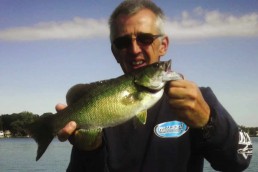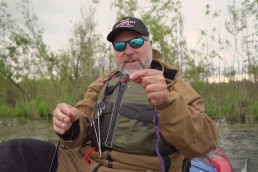SHARE THIS POST
A lot of things changed when I had to sell my bass boat.
At first, it drove me crazy. I had spent many years learning where bass congregate on the deep ledges and now I couldn’t reach them. I had also fished from a bass boat for well over a decade and worked as a guide on Kentucky Lake for seven years.
Now I was grounded.
Gradually, by moving around, prospecting and experimenting, I found a bunch of good spots where I could catch bass from the bank—quite a few in fact.
But my approach wasn’t the only thing that changed. I had found myself scaling down my baits, and not so much the size of them, but the weight. That’s when I really started catching more bass from the bank.
Going lighter wasn’t strategic or some clever calculation to catch more. At first, it was simply financial.
The biggest problem with bassin’ from the bank are the hang-ups. In the first place, you are working baits up a slope, not down it as you do from a boat, so you get hung up more. And because you can’t troll over, get above them and snap the line, you end up breaking most of them off. It was breaking the terminal-tackle tally and stressing my already cracked piggy bank.
When I started feeling I could catch as many or more bass from the bank was when I discovered Mann’s HardNose baits. This is trademarked bait, which includes a process that creates worms, soft-craws and other plastic baits with stiff, hard plastic on the first inch of the nose while the rest of the bait is supple and pliable. I could fish HardNose bait without any weight at all because the worm doesn’t slip down and ball up in the hook bend like all other worms do without a weight to run interference. Being able to fish weightless not only means I don’t get hung up, but also the presentation is so natural and lifelike I often catch big bass that pass up the heavy rigs of passing boat fishermen.
Are you enjoying this post?
You can be among the first to get the latest info on where to go, what to use and how to use it!
I rig their 6-inch worms on heavy-wire, 2/0 to 4/0 hooks (depending on the size of bait) just as I would with a Texas rig, except that I push the hook point a little farther through the nose of the bait before coming back out. That way, when I push the nose of the bait up over the “L,” the hard plastic of the nose covers the eye of the hook and the knot. This protects the knot, so I can get by with much lighter line, even if I was dragging a bullet weight around. There is almost no line abrasion and I usually use medium-action spinning gear and 10- or 12-pound-test line.
This is a rig for fishing shallow, but most bank fishing is shallow. With a heavy-wire, 3/0 or 4/0 hook–instead of the more expensive light-wire hooks–Mann’s 6-inch worms cast quite well and sink faster than most would suspect, at about 1 fps. I use it weightless down to 6 or 8 feet, and if I need to go deeper, a Hook Angel or two get it down in a dozen feet of water. You just need to be more patient on the fall and a little slower on the retrieve.
The slow fall, the slower retrieve and no extra weight or hardware attached is part of the reason this rig works well. It is as weedless and as lifelike as a piece of plastic can possibly be. And because the bass don’t feel any weight or line pressure when they pick it up, they hold onto it.
Fishing with it is actually easier than with a regular Texas Rig or Carolina Rig because you don’t need good hands to detect the strike before the bass feels resistance and spits it out. The line stays relatively slack, so they won’t spit it out, they’ll swallow the whole thing if you don’t pay attention—watch the line for any unusual tick or movements.
After you cast it out and let it go all the way to the bottom, don’t move your rod tip to move the bait, and don’t hold your rod tip high. Keep your rod tip relatively low and steady and move the bait simply by taking a single crank of the reel, pausing a few seconds between cranks to let the worm settle. High-visibility or fluorescent line makes watching the line easier, and on windy days I’ll put a little fly line dressing on a section of the line to keep it floating up and vulnerable.
With this rig you hardly ever feel resistance, as it works through brush, hops over rocks or climbs over stumps. Anytime you crank the reel and feel resistance of any kind, stop long enough to see if it wiggles or moves.
When I’m teaching someone to use this weightless rig I usually tell them that if they feel any resistance at all, set the hook. More often than not, it will be a fish, and quite often it will be a big one because big fish often inhale a bait and sit there or move off very slowly.
Recently, I was able to buy an old bass boat, but I now realize that what I learned while restricted to the bank was priceless. Fishing a weightless rig from the moving platform of a bass boat is a little trickier than from a stationary position along the bank, but it’s just as effective whenever bass are shallow. MWO
MWO
SHARE THIS POST
Did you enjoy this post?
You can be among the first to get the latest info on where to go, what to use and how to use it!
MWO
We believe being outdoors is good. With more than 1,000 articles each year, MidWest Outdoors magazine is all about sharing outdoor experiences with you—where to go, what to use and how to use it… whether you’re close to home or on that trip of a lifetime.


